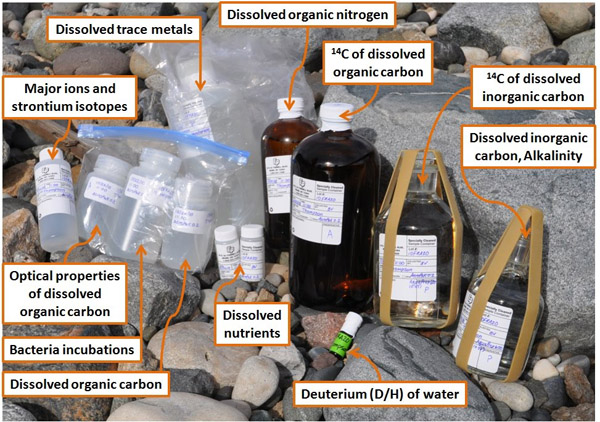Looking beyond particles, or: How I learned to stop worrying and love the dissolved phase
We decided the time has come to describe some of the other samples we’re collecting and what they add to the global rivers project. Our protocol reads a bit like a laundry list of standard water chemistry measurements, which exemplifies the overarching goal of this project and the Fraser’s special role in achieving these objectives. The Fraser is in many ways the easy river in this project, as it presents the fewest logistical obstacles (compared to the rivers being studied in Siberia, the Congo, the Indian subcontinent, and China). Not only is it feasible to transit the entire basin by car in a few weeks, we have local collaborators to help us acquire equipment and chemicals and ship samples back to WHOI, and we can rely on electrical power in the towns we visit. For this reason, we are not generally limited by the type and number of samples we can collect, so we try to collect everything we can!

In addition to the suspended particle and bank sediments, our water samples (for dissolved constituents) can generally be divided into two groups: inorganic and organic quantities. Today’s post will cover organics. This group includes dissolved organic carbon (DOC) concentration, dissolved organic nitrogen (DON) concentration, and radiocarbon (14C) content of DOC. DOC and DON give us an idea of which tributaries are the major sources of organic matter to the total river flux, but adding carbon isotopes (13C and 14C) tells us much more about the nature of the carbon sources. Different types of biota imprint different stable isotopic signatures on the organic matter they produce (leading to distinctive 13C values for carbon produced by trees, grasses, and algae growing in the river), and radiocarbon values are determined by the age of the organic matter (giving different 14C values for old material, such as aged soils, and young material, such as recently deceased plants).
We also collect samples which WHRC scientists will analyze for optical properties of DOC (a quick measurement which can give lots of information about the different compounds making up very complex DOC) and bacterial incubations (which quantifies the “lability” or freshness/tastiness of DOC to bacteria). These detailed characterizations of what kind of compounds make up DOC are of particular interest in the Arctic watersheds, and potentially also here in B.C., where climate change and other anthropogenic effects are altering the upper soil and permafrost layers. If very old reservoirs of carbon are being mobilized and exported by rivers, the nature and magnitude of fluxes of terrestrial carbon to the ocean could be changing significantly on short (human) timescales. We will also be sampling for lignins (organic compounds specific to terrestrial plants), but that’s a topic for a later post! Stay tuned for the inorganic side of the story…
